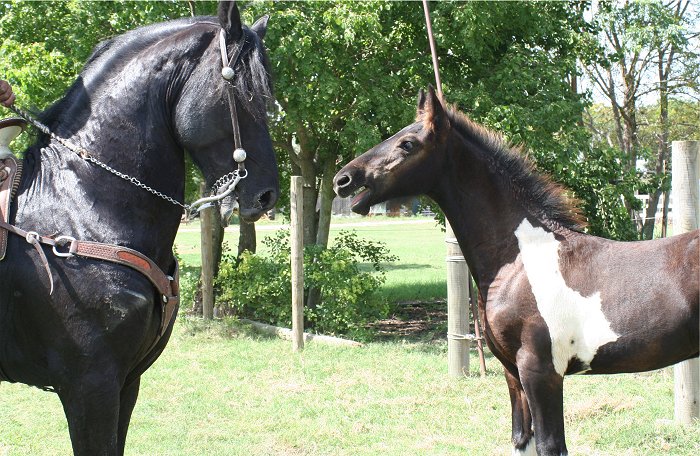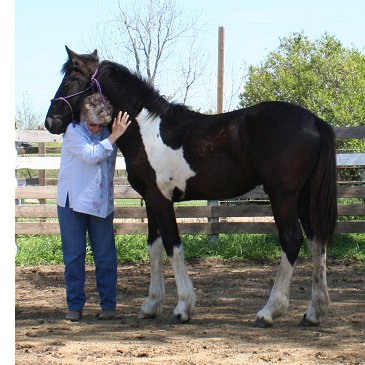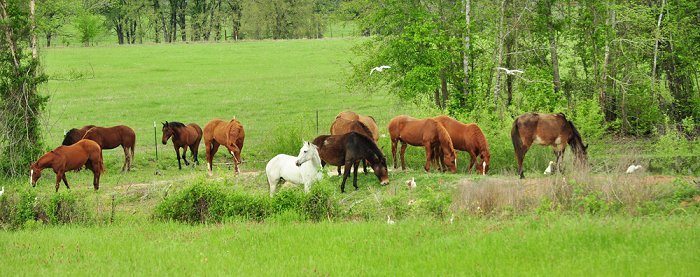Horses are natural herd animals and very insecure, uncomfortable, even unhappy, when not in the presence of other horses. There are many communication signals used by horses to understand each other’s intentions. Understanding horse communication is important for horse training, as most techniques try to closely simulate a horse’s natural communication skills.
 Lead (dominant) Mare: Stallions usually give warning if a predator is near or if another marauding stallion is trying to enter the herd. However, for day-to-day issues such as who eats where and when, who gets privileges, there is always one dominant mare in a pasture.
Lead (dominant) Mare: Stallions usually give warning if a predator is near or if another marauding stallion is trying to enter the herd. However, for day-to-day issues such as who eats where and when, who gets privileges, there is always one dominant mare in a pasture.
The lead horse in a pasture is not hard to identify. She will be in first position at the gate, at the trough, at the round bale. She will greet a visitor to the pasture first. Because she is used to intimidating the other horses, she should never be allowed to push her way into your space in a free environment or she will infer that she is the lead horse in your herd as well. YOU must ALWAYS retain the position of dominant horse in the pasture herd.
Watch for her to lay her ears very flat back against her head at the other horses as they push their way to her goal. If they have learned horse communication fluently, they will move away without any actual aggression. If they are too slow to respond to her signal, she will turn quickly and bite at them. If they are pressuring her space too severely, she may even let fly with both back feet. Most underlings never get caught by the feet unless another horse is in the way of their retreat and they can’t avoid the blow.
Frequently, the scuffle goes down a line of the pecking order: Lead mare kicks or bites horse near her. That horse kicks or bites the next horse down or nearest that is not above his station. The 3rd horse chooses an underling of his own to bite or run off. And so the dominance game goes until they reach the bottom of the order.
Unshod horses seldom cause real damage to each other during skirmishes. But horses wearing shoes can cause gashes, scars, even broken legs if they connect.
Stallions: Even breeding herds on ranches do not usually include a stallion. However, in the wild, a stallion is the protector of a herd to the exclusion of other mature male horses who will roam separately from the mare group in a bachelor herd. The head stallion warns of danger, but he rarely calls the shots – even when introducing a new mare. A lead mare has a lot of say about who joins and who does not.

Stallions are naturally competitive and will fight for dominance. Although not usual, two or even many stallions can be kept together in an enclosure if they are young with old or have had a chance to establish a pecking order in a large, non-dangerous environment such as a large pasture. However, if expected to get along, they should not share an enclosure with mares or mares in the vicinity at all.
 Young foals will show submission to stallions by running near them and opening their mouths wide to show teeth while hinging and unhinging their jaws or by clacking their teeth. Foals frequently present this behavior to all adult horses. In this case, the foal is about 4 months old and the black horse is a Friesian stallion (his sire).
Young foals will show submission to stallions by running near them and opening their mouths wide to show teeth while hinging and unhinging their jaws or by clacking their teeth. Foals frequently present this behavior to all adult horses. In this case, the foal is about 4 months old and the black horse is a Friesian stallion (his sire).
Bachelor Herds: These are the stallions who are not being bred to mares at the time. In the wild, they roam in their own group, away from the mare groups with their lead stallion. On large ranches, they sometimes pasture together after being introduced and establishing their own pecking order. Caspians are particularly amenable to that given enough space. Most of the Kristull Caspians were raised together.

Head Position: During skirmishes, each horse will try to gain the highest head position, snaking down only to gain advantage while biting. However, in a placid pasture, horses often stand with one’s head across the withers of another in a position of tactile camaraderie. (see Withers)
Ear Position: Horses who are alert to danger or extremely curious may stand with head high and ears erect. This head-up forward look concentrates their binocular vision on a distant object.
 Horses who are irritated put their ears flat back against their head to communicate to all around to move away.
Horses who are irritated put their ears flat back against their head to communicate to all around to move away.
When a horse is just listening, his ears may be relaxed-but-up or even in two different positions – one listening on the right or behind (such as to a rider on his back) and the other ear listening ahead. This is frequently seen on trail horses who are alert to the upcoming terrain and to their rider’s signals at the same time.
A horse who is relaxed may stand with ears semi-flopped.

Biting: Biting can be aggressive or submissive. An aggressive horse will swing around and take a big chunk of the rump, side, or other part of a horse that is in a more dominant horse’s space. It often precedes kicking.
However, horses seem to enjoy gentle biting of each other’s withers and necks in a kind of affectionate camaraderie (see the picture below). It seems to be soothing.
Horses that are fed treats can become pushy, biting in anticipation and demand. Treat training is discouraged by most trainers unless you understand the rules and stop demand-biting… DEFINITIVELY!
Kicking: Kicking is a second level communication. It is rarely indiscriminate and usually preceded by another signal such as flat-back ears or open-mouthed biting.
 Mutual Grooming and neck-resting: Horses quartered together often stand nose to tail to facilitate fly swatting. Each keeps the flies off of his partner’s face with his tail. They also stand with one resting his neck over the withers of the other. Touching seems to be important for relaxation. Should one fall asleep and the other alert to some danger, the sleeping horse is instantly alerted by the movement of his partner.
Mutual Grooming and neck-resting: Horses quartered together often stand nose to tail to facilitate fly swatting. Each keeps the flies off of his partner’s face with his tail. They also stand with one resting his neck over the withers of the other. Touching seems to be important for relaxation. Should one fall asleep and the other alert to some danger, the sleeping horse is instantly alerted by the movement of his partner.
I frequently stand under my horse’s neck in an effort to simulate (and stimulate) the bond that develops this way.
 Nibbling: Horse’s nibble each other as a sign of affection and bonding. If you stand near a horse and squeeze his withers and neck in a firm, massaging way, you will see him relax. It is a sign of mutual respect and care. Some horses will flex their neck around to start to “bite” you. This is usually not aggressive action, but an offer to return the massage and affection. However, it is not to be encouraged, as it is much too painful to a human.
Nibbling: Horse’s nibble each other as a sign of affection and bonding. If you stand near a horse and squeeze his withers and neck in a firm, massaging way, you will see him relax. It is a sign of mutual respect and care. Some horses will flex their neck around to start to “bite” you. This is usually not aggressive action, but an offer to return the massage and affection. However, it is not to be encouraged, as it is much too painful to a human.
See Fight or Flight instinct to understand horse aggression.
See Pressure to understand horse communication.
Turn Out: Because horses are herd animals, they are much healthier and happier when they have plenty of turn-out time with other horses. Ideally, all of our horses would have huge acreage to roam and graze. read: The Case Against Stalling
Many barns stall horses at night and have turn out during the day. If your horse must be stalled, see if he can be allowed to see and “talk to” the horses on either side. This communication and contact can help to prevent vices that bored, isolated horses develop such as weaving, cribbing, pawing, rubbing.
You may also notice that your horse needs less warm-up for riding if he is taken from turn out instead of a stall.
Under no circumstances should information presented here be construed as veterinary in nature. Always consult your veterinarian if problems persist. Additionally, horse training and equestrian activities in general can be dangerous. While we try to present relevant and valuable content, under no circumstances does horse-pros.com or its members or contributors take any responsibility for the well-being of any horse or person using a method outlined here.
Horse training and equestrian activities in general can be dangerous. While we try to present relevant and valuable content, under no circumstances does horse-pros.com or its members or contributors take any responsibility for the well-being of any horse or person using a method outlined here.
We certainly don’t know everything. Please share your expertise and experiences. Comment on what is already written or Suggest a Category and Educate us about it. Grow Horse-Pros.com©

Thank you for this article. How do you stop horse being pushy/aggressive in anticipation of treat DEFINATIVLEY.
I see that your question came in on the Pasture Etiquette page of the site. This page gives you some insight into a horse’s understanding of who is in charge. That is the problem with a pushy horse. You have not made him understand that YOU are in charge. No head mare would let an underling push his way to the hay bale. And you should not let your horse push his way to your treats.
No one ever wants to start at the beginning, but if you really want respect and a well-behaved horse, go back to lunging and start there. Get some respect.
Also, I recommend that you carry a whip, crop or training stick every time you go to the paddock, pasture or stall. You should approach your horse, talk to him, pet him. BUT if he gets so close that he is dangerous or keeping you off balance, or just making you uncomfortable, use the stick, whack him on the chest (small taps to big whacks depending on what it takes to back him up): tap, tap, TAP, TAP, WHACK!. When he is outside your circle of comfort, stop, drop the stick angle down, relax your body, and allow him to rest there. If he approaches again, tap/whack him again on the chest until he backs off. Repeat this until he understands that moving into your space is forbidden. (Whack him hard enough to get the appropriate result but not so hard he takes off like you shot him.) See the discussion of Pressure.
Timing is critical. Stop him the moment he takes a step toward you. Relax the moment he backs away.
For a while, don’t let him come up to you closer than about 5 feet. You go to him. Pet him. Love him. But don’t let him approach you.
And don’t treat him for a some time. Treating frequently leads to pushy, demanding horses who even resort to nipping or biting. It is the beginning of a downhill slide toward more dangerous behavior when he takes leadership position over you in other parts of your life together.
Once he seems to understand the rules, you can offer a treat again, but ONLY if he is respectful.
Horse from the photo “listening to the rider” is not “listening to the rider” but shows signs of being in pain because of too tight noseband and presumably too rough style of riding.
Thank you for taking the time to give us your observation. You seem to be well educated in horse and rider issues. Would you like to contribute something larger to the discussion? There are a lot of subjects we either don’t have included or are not knowledgeable enough to give good account. If you have one, send a picture of a horse “listening to the rider”. In the meantime, I will scour our archive to find one of our own horses listening.
See the questions on our Welcome Page that relate to this post but were asked on the wrong thread. Is a horse putting its head on your shoulder, affection, or dominance? I’m pretty sure its affection, but just making sure. (Congratulations on updating your site! It looks great!)